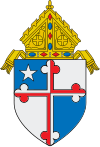|
Cathedral of Mary Our Queen, Baltimore
The Cathedral of Mary Our Queen is a Roman Catholic cathedral located Baltimore, Maryland, United States. It was completed in 1959. The cathedral is the seat of the Archbishop of Baltimore. It replaced the Basilica of the National Shrine of the Assumption of the Blessed Virgin Mary, which now serves as co-cathedral for the archdiocese. The cathedral is located in the Homeland area of northern Baltimore, near Loyola University Maryland and St. Mary's Seminary and University. HistoryBy the mid-20th century, the archdiocese started planning for a larger cathedral to replace the Cathedral of the Assumption in Baltimore.[1] The archdiocese was able to use a $20 million bequest from Thomas J O'Neill, a dry goods merchant. He believed that divine intervention had saved his department store from a massive fire in Baltimore in 1904.[2][3]  In October 1954, the archdiocese broke ground for Mary Our Queen. On October 13, 1959, Auxiliary Bishop Jerome Sebastian of Baltimore consecrated the new cathedral.[1] Pope St. John Paul II visited Mary Our Queen in 1976 and in 1995. ArchitectureMary Our Queen is a Gothic Revival structure with Art Deco accents. It was constructed of brick-faced with limestone, and has a classical east-facing cruciform floor plan. The cathedral measures 373 feet (114 m) long, 132 feet (40 m) wide and 163 feet (50 m) to the top of the two spires. It can accommodate 2,000 people. Mary Our Queen features an extensive sculptural program executed by Joseph Coletti.[4][1] CryptThe crypt below the main floor of Mary Our Queen serves as a burial place for the archbishops and auxiliary bishops of Baltimore.
Organs Mary Our Queen has two organs: the Great Gallery organ and the chancel organ.. The original organs were Opus 9200 of the M. P. Moller Company of Hagerstown, Maryland. After 46 years of use and some considerable damage due to water and smoke, the archdiocese in 2005 decided to restore both organs. It chose Schantz Organ Co. of Ohio to restore and replace many parts of the original instruments. The restoration began with the Great Gallery organ, then continued with the chancel organ. In addition to new pipe work, voice work, and new wind chests, Schantz built two new identical four-manual consoles—one for the gallery and one for the chancel—allowing the organist to control both organs from either location. The chancel console can be moved around the sanctuary to suit various needs. In the original Moller installation, the Great Gallery organ console had four-manuals and could control over both the gallery and sanctuary organs. The sanctuary organ console was two manuals, had complete control over the sanctuary organ and the gallery organ through "blind" controls. The sanctuary console was replaced in 1974 due to a fire in the console which caused smoke damage to both organs' pipework. After the renovations, the Great Gallery organ holds 100 ranks, and the sanctuary organ holds 27.[5] The first solo concert performance on the restored organ occurred July 5, 2007, by Cherry Rhodes as part of the closing ceremonies of the American Guild of Organists regional convention held in Baltimore.[6] The organ was played in recital during the Organ Historical Society Convention in July 2024.[7] See alsoWikimedia Commons has media related to Mary Our Queen Cathedral, Baltimore.
References
External links |
||||||||||||||||||||||||||||||||||||||||||||||||||||||||||||||||||||


